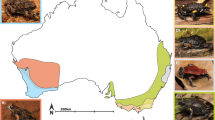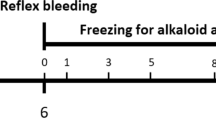Abstract
Many plants and animals store toxic or unpalatable compounds in tissues that are easily encountered by predators during attack. Defensive compounds can be produced de novo, or obtained from dietary sources and stored directly without selection or modification, or can be selectively sequestered or biotransformed. Storage strategies should be optimized to produce effective defence mechanisms but also prevent autotoxicity of the host. Nudibranch molluscs utilize a diverse range of chemical defences, and we investigated the accumulation and distribution of defensive secondary metabolites in body tissues of 19 species of Chromodorididae nudibranchs. We report different patterns of distribution across tissues, where: 1) the mantle had more or different (but structurally related) compounds than the viscera; 2) all compounds in the mantle were also in the viscera; and 3) the mantle had fewer compounds than the viscera. We found no further examples of species that selectively store a single compound, previously reported in Chromodoris species. Consistent with other studies, we found high concentrations of metabolites in mantle rim tissues compared to the viscera. Using bioassays, compounds in the mantle were more toxic than compounds found in the viscera for Glossodoris vespa Rudman, 1990 and Ceratosoma brevicaudatum Abraham, 1876. In G. vespa, compounds in the mantle were also more unpalatable to palaemonid shrimp than compounds found in the viscera. This indicates that these species may modify compounds to increase bioactivity for defensive purposes and/or selectively store more toxic compounds. We highlight clear differences in the storage of sequestered chemical defences, which may have important implications for species to employ effective defences against a range of predators.



Similar content being viewed by others
References
Abbott W (1925) A method of computing the effectiveness of an insecticide. J Econ Entomol 18:265–267
Abraham PS (1876) Notes on some genera of nudibranchiate Mollusca, with notices of a new genus and some hitherto undescribed species, in the collection of the British Museum. Ann Mag Nat Hist 4(18):132–146 pls. 6–7
Angas GF (1864) Description d’especes nouvelles appurtenant a plusiers genres de Mollusques Nudibranches des environs de Port-Jackson (Nouvelle-Galles du Sud), accompagnee de dessins faits d’apres nature (GFA & H Crosse). J Conchyliol 12:43–70 pls. 4–6
Avila C (1995) Natural products of opisthobranch molluscs: a biological review. Ocean Mar Biol 33:487–559
Avila C, Paul VJ (1997) Chemical ecology of the nudibranch Glossodoris pallida: is the location of diet-derived metabolites important for defense? Mar Ecol Prog Ser 150:171–180
Bergh LSR (1905) Die Opisthobranchiata der Siboga-expedition. Monographie 50. Brill, Leiden
Blunt JW, Copp BR, Keyzers RA, Munro M, Prinsep MR (2015) Marine natural products. Nat Prod Rep 32:116–211
Carbone M, Gavagnin M, Haber M, Guo YW, Fontana A, Manzo E, Genta-Jouve G, Tsoukatou M, Rudman WB, Cimino G, Ghiselin MT, Mollo E (2013) Packaging and delivery of chemical weapons: a defensive Trojan horse stratagem in chromodorid nudibranchs. PLoS One 8:e62075
Cheney KL, White A, Mudianta IW, Winters AE, Quezada M, Capon RJ, Mollo E, Garson MJ (2016) Choose your weaponry: selective storage of a single toxic compound, latrunculin A, by closely related nudibranch molluscs. PLoS One 11:e0145134. https://doi.org/10.1371/journal.pone.0145134
Cortesi F, Cheney KL (2010) Conspicuousness is correlated with toxicity in marine opisthobranchs. J Evol Biol 23:1509–1518
Dumdei EJ, Flowers AE, Garson MJ, Moore CJ (1997) The biosynthesis of sesquiterpene isocyanides and isothiocyanates in the marine sponge Acanthella cavernosa (Dendy); evidence for dietary transfer to the dorid nudibranch Phyllidiella pustulosa. Comp Biochem Physiol A Physiol 118:1385–1392
Eisner T, Grant RP (1981) Toxicity, odor aversion, and “olfactory aposematism.”. Science 213:476
Eisner T, Meinwald J, Monro A, Ghent R (1961) Defence mechanisms of arthropods—I the composition and function of the spray of the whipscorpion, Mastigoproctus giganteus (Lucas)(Arachnida, Pedipalpida). J Insect Physiol 6:272–298
Fahey SJ, Garson MJ (2002) Geographic variation of natural products of tropical nudibranch Asteronotus cespitosus. J Chem Ecol 28 (9):1773–1785. https://doi.org/10.1023/A:1020509117545
Faulkner DJ, Molinski TF, Andersen RJ, Dumdei EJ, De Silva ED (1990) Geographical variation in defensive chemicals from Pacific coast dorid nudibranchs and some related marine molluscs. Comp Biochem Pysiol C 97:233–240
Fontana A, Avila C, Martinez E, Ortea J, Trivellone E, Cimino G (1993) Defensive allomones in three species of Hypselodoris (Gastropoda: Nudibranchia) from the Cantabrian Sea. J Chem Ecol 19:339–356
Fontana A, Gimenez F, Marin A, Mollo E, Cimino G (1994) Transfer of secondary metabolites from the sponges Dysidea fragilis and Pleraplysilla spinifera to the mantle dermal formations (MDFs) of the nudibranch Hypselodoris webbi. Experientia 50:510–516
García-Gómez J, Cimino G, Medina A (1990) Studies on the defensive behaviour of Hypselodoris species (Gastropoda: Nudibranchia): ultrastructure and chemical analysis of mantle dermal formations (MDFs). Mar Biol 106:245–250
Garrett A (1873) Descriptions of new species of marine shells inhabiting the South Sea islands. Proc Acad Nat Sci Phila 1873:209–231
Giordano G, Carbone M, Ciavatta ML, Silvano E, Gavagnin M, Garson MJ, Cheney KL, Mudianta IW, Russo GF, Villani G, Magliozzi L, Polese G, Zidorn C, Cutignano A, Fontana A, Ghiselin MT, Mollo E (2017) Volatile secondary metabolites as olfactory signals and defensive weapons in aquatic environments. Proc Natl Acad Sci 114:3451–3456
Gunthorpe L, Cameron A (1987) Bioactive properties of extracts from Australian dorid nudibranchs. Mar Biol 94:39–43
Haber M, Cerfeda S, Carbone M, Calado G, Gaspar H, Neves R, Maharajan V, Cimino G, Gavagnin M, Ghiselin MT, Mollo E (2010) Coloration and defense in the nudibranch gastropod Hypselodoris fontandraui. Biol Bull 218:181–188
Heller C (1862). Neue Crustaceen, gesammelt während der Weltumseglung der k.k. Fregatte Novara. Zweiter vorläufiger Bericht. Verh Zool-Bot Ges Wien 12:519–528
Johnson RJ, Gosliner TM (2012) Traditional taxonomic groupings mask evolutionary history: a molecular phylogeny and new classifications of the chromodorid nudibranchs. PLoS One 7(4):e33479. https://doi.org/10.1371/journal.pone.0033479
Karuso P (1987) Chemical ecology of the nudibranchs. In: Scheuer PJ (eds) Bioorganic marine chemistry. vol 1. Springer, Berlin, Heidelberg
Katoh K, Toh H (2008) Improved accuracy of multiple ncRNA alignment by incorporating structural information into a MAFFT-based framework. BMC Bioinformatics 9:212
Kearse M, Moir R, Wilson A, Stones-Havas S, Cheung M, Sturrock S, Buxton S, Cooper A, Markowitz S, Duran C, Thierer T, Ashton B, Meintjes P, Drummond A (2012) Geneious basic: an integrated and extendable desktop software platform for the organization and analysis of sequence data. Bioinformatics 28:1647–1649
Keyzers RA, Northcote PT, Davies-Coleman MT (2006) Spongian diterpenoids from marine sponges. Nat Prod Rep 23:321−334
Kubanek J, Faulkner DJ, Andersen RJ (2000) Geographic variation and tissue distribution of endogenous terpenoids in the northeastern Pacific Ocean dorid nudibranch Cadlina luteomarginata: implications for the regulation of de novo biosynthesis. J Chem Ecol 26:377–389
Lindigkeit R, Biller A, Buch M, Schiebel HM, Boppré M, Hartmann T (1997) The two faces of pyrrolizidine alkaloids: the role of the tertiary amine and its N-oxide in chemical defense of insects with acquired plant alkaloids. Eur J Biochem 245:626–636
Manzo E, Gavagnin M, Somerville MJ, Mao SC, Ciavatta ML, Mollo E, Schupp PJ, Garson MJ, Guo YW, Cimino G (2007) Chemistry of Glossodoris nudibranchs: specific occurrence of 12-keto scalaranes. J Chem Ecol 33:2325–2336
Marin A, Belluga ML, Scognamiglio G, Cimino G (1997) Morphological and chemical camouflage of the Mediterranean nudibranch Discodoris indecora on the sponges Ircinia variabilis and Ircinia fasciculata. J Molluscan Stud 63:431–439
Mollo E, Gavagnin M, Carbone M, Guo Y-W, Cimino G (2005) Chemical studies on Indopacific Ceratosoma nudibranchs illuminate the protective role of their dorsal horn. Chemoecology 15:31–36
Mollo E, Gavagnin M, Carbone M, Castelluccio F, Pozone F, Roussis V, Templado J, Ghiselin MT, Cimino G (2008) Factors promoting marine invasions: a chemoecological approach. Proc Natl Acad Sci 105:4582–4586
Mollo E, Garson MJ, Polese G, Amodeo P, Ghiselin MT (2017) Taste and smell in aquatic and terrestrial environments. Nat Prod Rep 34:596–513
Nishida R (2002) Sequestration of defensive substances from plants by Lepidoptera. Annu Rev Entomol 47:57–92
Pasteels J-M, Grégoire J-C, Rowell-Rahier M (1983) The chemical ecology of defense in arthropods. Annu Rev Entomol 28:263–289
Ratcliffe JM, Nydam ML (2008) Multimodal warning signals for a multiple predator world. Nature 455:96–99
Rogers SD, Paul, VJ (1991) Chemical defenses of three Glossodoris nudibranchs and their dietary Hyrtios sponges. Mar Ecol Prog Ser 77:221–232
Rudman WB (1983) The Chromodorididae (Opisthobranchia: Mollusca) of the Indo-West Pacific: Chromodoris splendida, C. aspersa and Hypselodoris placida colour groups. Zool J Linnean Soc 78(2):105–173
Rudman WB (1984) The Chromodorididae (Opisthobranchia: Mollusca) of the Indo-West Pacific: a review of the genera. Zool J Linnean Soc 81(2):115–273
Rudman WB (1987) The Chromodorididae (Opisthobranchia: Mollusca) of the Indo-West Pacific: Chromodoris epicuria, C. aureopurpurea, C. annulata, C. coi and Risbecia tryoni colour groups. Zool J Linnean Soc 90(4):305–407
Rudman WB (1990) The Chromodorididae (Opisthobranchia: Mollusca) of the Indo-West Pacific: further species of Glossodoris, Thorunna and the Chromodoris aureomarginata colour group. Zool J Linnean Soc 100:263–326
Rudman WB, Bergquist PR (2007) A review of feeding specificity in the sponge-feeding Chromodorididae (Nudibranchis: Mollusca). Molluscan Res 27:60–88
Silvestro D, Michalak I (2012) raxmlGUI: a graphical front-end for RAxML. Org Divers Evol 12:335–337
Somerville MJ, Mollo E, Cimino G, Rungprom W, Garson MJ (2006) Spongian diterpenes from Australian nudibranchs: an anatomically guided chemical study of Glossodoris atromarginata. J Nat Prod 69:1086–1088
Stamatakis A (2006) RAxML-VI-HPC: maximum likelihood-based phylogenetic analyses with thousands of taxa and mixed models. Bioinformatics 22:2688–2690
Sword GA (2001) Tasty on the outside, but toxic in the middle: grasshopper regurgitation and host plant-mediated toxicity to a vertebrate predator. Oecologia 128:416–421
Turner LM, Wilson NG (2008) Polyphyly across oceans: a molecular phylogeny of Chromodorididae (Mollusca, Nudibranchia). Zool Scr 37:23–42
Wägele H, Ballesteros M, Avila C (2006) Defensive glandular structures in opisthobranch molluscs–from histology to ecology. In: Gibson RN, Atkinson RJA, Gordon JDM (eds) Oceanography and marine biology, vol 44. Taylor & Francis Group, Florida, pp 197–276
Walen KE, Sotka EE, Goldstone JV, Hahn ME (2010) The role of multixenobiotic transporters in predatory marine molluscs as counter-defense mechsnisms against dietary allelochemicals. Comp Biochem Physiol C Toxicol Pharmacol 152:288–300
Wilson NG, Lee MS (2005) Molecular phylogeny of Chromodoris (Mollusca, Nudibranchia) and the identification of a planar spawning clade. Mol Phylogenet Evol 36:722–727
Winters AE, Green NF, Wilson NG, How MJ, Garson MJ, Marshall NJ, Cheney KL (2017) Stabilizing selection on individual pattern elements of aposematic signals. Proc R Soc Lond B Biol Sci 284:20170926. https://doi.org/10.1098/rspb.2017.0926
Zhao J-Z, Cao J, Li Y, Collins HL, Roush RT, Earle ED, Shelton AM (2003) Transgenic plants expressing two Bacillus thuringiensis toxins delay insect resistance evolution. Nat Biotechnol 21:1493–1497
Acknowledgments
We would like to thank Talia Pettigrew and Gloria Miller for help with chemical extractions and Sean Young for help running assays. This work was funded by the Australian Pacific Science Foundation (APSF) (awarded to KLC and MJG) and The University of Queensland Promoting Women Fellowship (awarded to KLC). Anne Winters was supported by an Endeavour Postgraduate Scholarship.
Author information
Authors and Affiliations
Corresponding authors
Ethics declarations
Conflict of Interest
The authors declare that they have no conflict of interest.
Rights and permissions
About this article
Cite this article
Winters, A.E., White, A.M., Dewi, A.S. et al. Distribution of Defensive Metabolites in Nudibranch Molluscs. J Chem Ecol 44, 384–396 (2018). https://doi.org/10.1007/s10886-018-0941-5
Received:
Revised:
Accepted:
Published:
Issue Date:
DOI: https://doi.org/10.1007/s10886-018-0941-5




